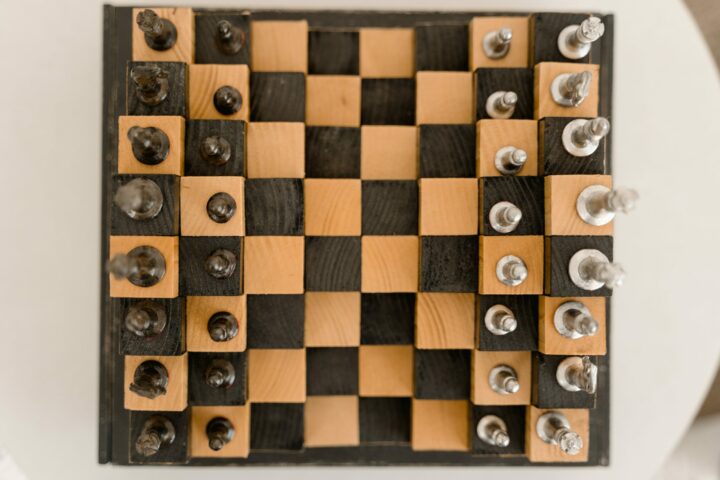Welcome to the intriguing world of chess! If you’ve found yourself here, seeking guidance on how to play against the Caro-Kann Defense, you’re in the right place. The Caro-Kann Defense is a popular chess opening characterized by the moves 1.e4 c6. It has been employed by many strong players throughout history, making it essential for any aspiring chess enthusiast to develop a solid strategy to counter it.
In this guide, we will explore various approaches and techniques that will equip you with the knowledge and skills to effectively play against the Caro-Kann Defense. From tactical maneuvers to positional concepts, we’ll delve into the intricacies of this opening, helping you gain an upper hand in your games.
Whether you’re a beginner looking to enhance your chess repertoire or an experienced player aiming to refine your strategies, our aim is to provide you with valuable insights and practical tips to confront the Caro-Kann Defense confidently. By understanding the underlying principles, key ideas, and typical plans associated with this opening, you’ll be well-prepared to navigate the complexities of the chessboard and outwit your opponent.
So, let’s embark on this exciting chess journey together as we unravel the mysteries of the Caro-Kann Defense. Prepare yourself to unlock new possibilities, sharpen your skills, and ultimately emerge as a more formidable chess player.
What is the Caro-Kann Defense and Why Should You Care?
The Caro-Kann Defense is a popular chess opening that arises after the moves 1.e4 c6. It is named after the players Horatio Caro and Marcus Kann, who analyzed this opening extensively in the late 19th century. The Caro-Kann Defense is characterized by Black’s solid pawn structure and the intention to control the center and develop harmoniously.
Understanding the Caro-Kann Defense is crucial for every chess player because it provides a solid and reliable weapon against the aggressive 1.e4 opening move. By studying this opening, you’ll gain insights into key strategic ideas, pawn structures, and typical plans, which will not only help you counter the Caro-Kann Defense effectively but also enhance your overall understanding of chess openings.
How Does the Caro-Kann Defense Influence the Opening Stage?
The Caro-Kann Defense has a significant influence on the opening stage of a chess game. By playing 1…c6, Black aims to restrict White’s pawn breaks in the center and establish a strong presence in the central squares with pawns on d5 and e6.
This solid pawn structure often leads to strategic battles where both players maneuver their pieces carefully to gain positional advantages. The Caro-Kann Defense encourages players to focus on development, piece activity, and solidifying their position before launching aggressive attacks.
By comprehending the unique dynamics introduced by the Caro-Kann Defense, you’ll be better equipped to navigate the complexities of the opening phase and make informed decisions to gain an edge over your opponent.

Is the Caro-Kann Defense Suitable for Every Player?
While the Caro-Kann Defense has been a trusted choice for many strong players, it may not be suitable for every player’s style or preferences. The Caro-Kann Defense is typically favored by those who appreciate solidity, positional maneuvering, and the potential for counterplay.
If you enjoy strategic battles, building a solid foundation, and patiently exploiting your opponent’s mistakes, the Caro-Kann Defense might be an excellent fit for you. However, if you prefer sharp tactical positions or a more aggressive style, you may find other openings more to your liking.
It’s important to assess your playing style, strengths, and weaknesses to determine if the Caro-Kann Defense aligns with your chess aspirations.
What Are the Key Principles of Playing Against the Caro-Kann Defense?
When facing the Caro-Kann Defense, understanding the key principles can greatly enhance your chances of success. It is crucial to recognize the importance of central control, as Black aims to establish a strong presence in the center with pawns on d5 and e6.
By challenging and undermining Black’s pawn structure, you can create imbalances and exploit potential weaknesses. Piece development and activity are also paramount, allowing you to exert pressure on Black’s position and restrict their counterplay.
Additionally, understanding typical Caro-Kann pawn structures and strategical themes will enable you to formulate effective plans and find favorable positional advantages. By adhering to these principles, you can navigate the complexities of the Caro-Kann Defense and make informed decisions that maximize your chances of success.
How Can You Exploit the Weaknesses in the Caro-Kann Defense?
Exploiting weaknesses in the Caro-Kann Defense requires a keen understanding of the opening’s pawn structures and strategic ideas. One common weakness to target is the isolated pawn on d5, which can become a target for attacks and tactical combinations.
By placing pressure on this isolated pawn, you can restrict Black’s piece activity and create imbalances in the position. Additionally, the pawn break c4 can sometimes undermine Black’s pawn structure and open lines for your pieces to infiltrate.
Moreover, exploiting the delayed development of Black’s light-squared bishop and finding ways to challenge the solid pawn structure can also be effective strategies. By identifying and capitalizing on these weaknesses, you can disrupt Black’s plans and gain an advantage in the game.
Which Are the Most Effective Opening Moves Against the Caro-Kann Defense?

Choosing the most effective opening moves against the Caro-Kann Defense depends on your playing style and preferences. However, certain moves have proven to be popular and successful. The move 2.Nc3 is a common choice, aiming to control the center and develop the knight while preparing to castle kingside.
Alternatively, 2.d4, known as the Classical Variation, leads to a more open and tactical position, challenging Black’s central pawn structure. Another option is the Exchange Variation with 2.exd5, simplifying the position and reducing Black’s counterplay.
Each move has its own nuances and strategic implications, so it’s essential to study and understand the ideas behind them to make informed decisions and adapt to your opponent’s responses effectively.
How Do You Handle the Caro-Kann Exchange Variation?
The Caro-Kann Exchange Variation occurs after the moves 1.e4 c6 2.d4 d5 3.exd5 cxd5. In this variation, White willingly exchanges pawns in the center, simplifying the position and aiming to create long-term strategic advantages. To handle this variation effectively, it’s crucial to understand the resulting pawn structure and adjust your plans accordingly.
Typically, in the Exchange Variation, both players focus on piece development, piece activity, and the control of key squares. It’s important for White to capitalize on the half-open d-file and seek ways to exert pressure on Black’s position.
Black, on the other hand, aims to develop harmoniously, contest the d-file, and find ways to challenge White’s central control. By understanding the specific characteristics and strategic ideas behind the Caro-Kann Exchange Variation, you can navigate the resulting positions with confidence.
| Caro-Kann Variation | Advantages | Key Strategies |
|---|---|---|
| Classical Variation | Solid pawn structure, control of the center | Focus on development and piece coordination |
| Advance Variation | Space advantage, potential to cramp Black’s position | Exploit weak squares, target isolated pawns |
| Panov-Botvinnik Attack | Central control, dynamic pawn structure | Initiate a central pawn break, active piece play |
| Exchange Variation | Central control, simplified position | Exploit isolated pawns, create pressure on weak squares |
| Fantasy Variation | Aggressive pawn structure, the potential for a kingside attack | Prepare pawn storm, active piece development |
What Are the Most Common Tactics in the Caro-Kann Defense?
The Caro-Kann Defense offers opportunities for tactical skirmishes, and being familiar with the common tactics can be advantageous. One common tactic is the “Hanging Pawns” motif, where Black’s pawns on d5 and e6 become vulnerable to tactical attacks.
Exploiting pins, forks, and discovered attacks can often lead to material gains or positional advantages. Additionally, tactical themes such as trapped pieces, skewers, and back-rank weaknesses may arise in certain variations of the Caro-Kann Defense.
By studying and recognizing these tactics, you can spot opportunities to gain an edge and successfully navigate the dynamic nature of the Caro-Kann Defense.
How Can You Break Through the Solid Caro-Kann Defense Structure?
The Caro-Kann Defense is known for its solid pawn structure, making it challenging to break through directly. However, there are strategies to create imbalances and exploit potential weaknesses. One approach is to undermine Black’s central control by applying pressure on the d5 pawn or targeting the weak squares around it.
Pawn breaks like f4 or b4 can disrupt Black’s pawn structure and create open lines for your pieces. Moreover, initiating a kingside attack can divert Black’s defensive resources and create tactical opportunities. By adopting a patient yet determined approach, combined with accurate calculation and strategic planning, you can break through the solid Caro-Kann Defense structure and seize the initiative.
How Do You Counter the Caro-Kann Fantasy Variation?
The Caro-Kann Fantasy Variation occurs after the moves 1.e4 c6 2.d4 d5 3.f3. This ambitious setup by White aims to challenge Black’s central pawn structure and restrict their pawn breaks. To counter this variation effectively, Black can focus on solid piece development, establishing a strong pawn structure, and seeking tactical opportunities.
One possible approach is to exploit the potential weaknesses created by White’s pawn on f3, which can become a target for future attacks. By contesting the center, developing harmoniously, and applying positional pressure, Black can neutralize White’s aggressive intentions and strive for an advantageous position.
Should You Opt for Aggressive or Solid Strategies against the Caro-Kann Defense?
Deciding whether to adopt aggressive or solid strategies against the Caro-Kann Defense depends on various factors, including your personal playing style, the specific variation being played, and the position on the board. Both aggressive and solid approaches can be effective if applied appropriately.
Aggressive players might opt for tactical complications, attacking chances, and dynamic piece plays to put pressure on Black. On the other hand, players favoring solid strategies may focus on controlling key squares, reinforcing their pawn structure, and gradually improving their position. It’s important to assess the position and your opponent’s weaknesses and tendencies to determine the most suitable strategy that aligns with your strengths and preferences.
How Can You Prevent Counterplay in the Caro-Kann Defense?

Preventing counterplay in the Caro-Kann Defense requires careful planning and proactive measures. One key aspect is maintaining a solid pawn structure and controlling key squares, denying your opponent opportunities for active piece play. Restricting Black’s pawn breaks and minimizing tactical vulnerabilities can limit their counterplay possibilities.
Additionally, maintaining harmonious piece coordination and maintaining pressure on Black’s position can restrict their options for generating counterplay. By identifying potential sources of counterplay and proactively addressing them through accurate calculation, strategic prophylaxis, and accurate piece placement, you can effectively prevent your opponent from gaining momentum and maintain control over the game.
Can You Utilize Pawn Sacrifices to Gain Advantage in the Caro-Kann Defense?
Utilizing pawn sacrifices as a strategic tool in the Caro-Kann Defense can be a dynamic and resourceful approach. While pawn sacrifices should not be taken lightly, there are situations where sacrificing a pawn can lead to long-term advantages, such as piece activity, open lines, or weakening your opponent’s pawn structure.
The decision to sacrifice a pawn should be based on careful evaluation of the position, potential compensation, and the resulting imbalances. By accurately assessing the tactical and strategic implications, you can make calculated pawn sacrifices to gain the initiative, create attacking opportunities, or disrupt your opponent’s plans.
However, it’s crucial to maintain a balanced approach, weighing the risks and rewards, and ensuring sufficient compensation for the sacrificed material.
The Bottom Line
In conclusion, playing against the Caro-Kann Defense in chess requires a combination of strategic understanding, tactical awareness, and adaptability. By familiarizing yourself with the key principles, common tactics, and effective opening moves, you can navigate the complexities of this popular defense.
It’s important to recognize the Caro-Kann Defense’s solid pawn structure, potential weaknesses, and the specific strategic ideas associated with it. Whether you choose aggressive or solid strategies, the key is to maintain control of the center, develop harmoniously, and exploit any opportunities that arise. As the game progresses from the opening to the middle game and potentially into the endgame, it’s crucial to adapt your plans, assess imbalances, and make accurate decisions to gain an advantage.
With practice, study, and a deep understanding of the Caro-Kann Defense, you can confidently face this opening and increase your chances of success on the chessboard. So, embrace the challenge, explore different strategies, and enjoy the intellectual battle as you strive for victory against the Caro-Kann Defense.




